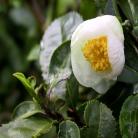Green tea
PRESENTATION OF THE PLANT
The tea plant is a kind of evergreen laurel tree that spontaneously grows widely from tropical to temperate regions in Asia and has been closely associated with people’s life since the down of the history. People utilised the leaves or its infusions as a medicine at first and then, to make a luxury drink. At present the tea plant is cultivated in more than 20 countries of Asia, Africa, and South America as one of the most favourite horticultural plants just like coffee and cacao. It is a popular beverage widely consumed throughout the world in different forms, including green (unfermented), oolong (semi-fermented) and black (fully-fermented).
China, Japan, Indonesia and Vietnam are the major producers and consumers of green tea. The commercially grown tea plant, classified as Camellia sinensis L., is maintained as an evergreen shrub by pruning.
In tropical countries it is harvested throughout the year while in temperate countries such as Japan, the harvest is seasonal. Green tea is then produced through standardised procedures from young shoots consisting of two or three leaves. After the enzymatic inactivation is achieved by steam or pan firing treatment to preserve the chemical and flavour attributes, the leaves are dried with hot air. The natural constituents and also the greenish colour are largely preserved in this manner.
ACTIVE INGREDIENTS
The green tea leaf is particularly rich in polyphenols (more than 10%), mainly catechin and derivatives (gallocatechin, epicatechin, epicatechin gallate, epigallocatechin, epigallocatechin gallate). It also contains caffeine (1-4%), amino-acids (2-3 %), flavonoids, vitamins (A, B1, B2, C), minerals and trace elements (especially fluorine).
COSMETIC PROPERTIES
1. Green tea is a strong antioxidant
Human cells are constantly exposed to free radicals produced by endogenous sources but also generated by an immune response or as a result of smoking, air pollution and the influence of UV light on the skin. Chronic exposure to these free radicals from the environment can damage DNA, membrane lipids, lipoproteins and functional and structural proteins such as collagen and elastin, and thus play a major role in skin ageing.
Green tea polyphenols appear to be an efficacious ingredient against this oxidative stress, as observed from several experiments. In September 1997, a study by Dr. L. Mitscher from the University of Kansas concluded that a catechin in green tea, epigallocatechin gallate (EGCG), was more than 100 times as effective at neutralising free radicals as vitamin C, and 25 times more powerful than vitamin E that are well known antioxidants.
2. Green tea has interesting astringent properties
The astringent action of green tea polyphenols, like other tannins, is based primarily on the biding of proteins on the surface of moist skin layers. Externally, they waterproof the external layers of the skin, thus protecting the underlying layers. By limiting fluid losses, and by preventing external aggressions, tannins enhance tissue regeneration in case of superficial wound and burn. They also reduce sebaceous secretions and have clearly demonstrated antiseptic effects.
3. Green tea offers microcirculatory properties
Polyphenols and flavonoids increase the resistance of capillaries by decreasing their permeability and thus offer positive circulatory properties to the skin.
4. Green tea prevents growth of the skin bacteria responsible for body malodour formation and acne.
Several studies have shown that green tea can suppress the growth of bacteria such as Staphylococcus epidermis, Corynebacterium xerosis and Propionibacterium acnes, that are involved in body malodour or acne formation.
5. Green tea contains interesting concentrations of caffeine and is therefore valuable for anti-cellulite products.
Caffeine has a double action against the cellulite. It stimulates the activity of enzymes responsible for the lipolysis (conversion of the fatty reserves into glycerol and free fatty acids), thus favouring to break down triglycerides and trigger their release. It is also desinfiltrant and prevents from an excessive hydrous retention in the connective tissue.
|

|





